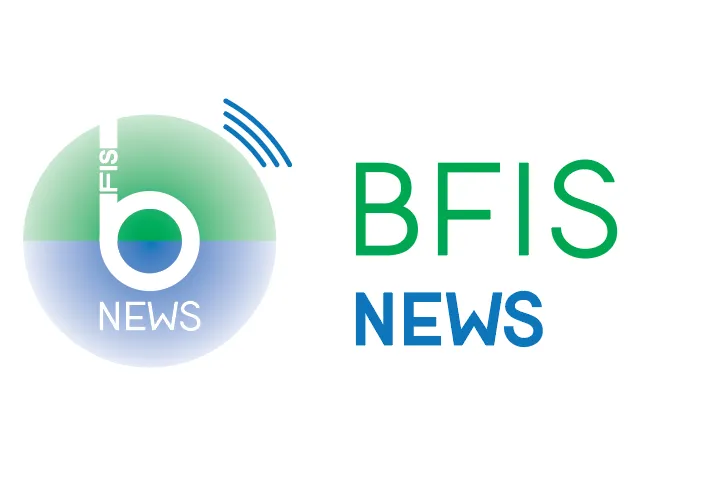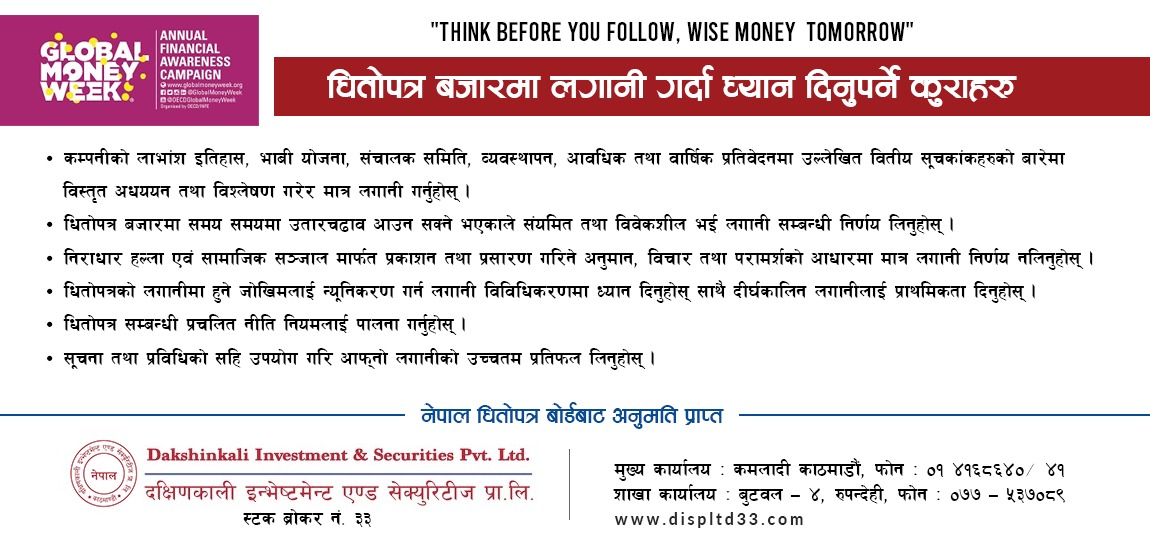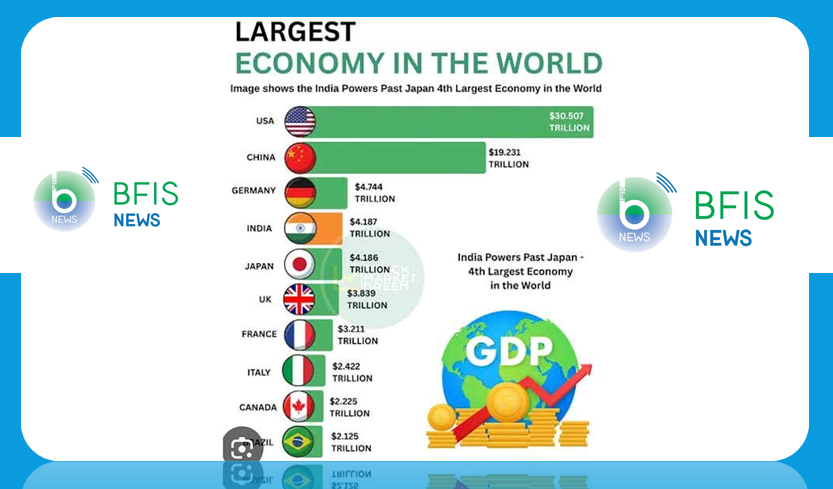Nepal Rastra Bank Publishes the Fifteenth Financial Stability Report, Executive Summary
- BFIS News
- 2024 Jun 18 22:04

kathmandu. The Nepal Rastra Bank (NRB) has released the fifteenth edition of its Financial Stability Report, offering an insightful overview of the nation's financial sector as of mid-July 2023. This comprehensive report, based on provisional data from Bank and Financial Institutions (BFIs), financial markets, financial infrastructures, and other financial institutions, highlights key developments and policy measures taken during the review period. It is noteworthy that some of the data used may differ from the most recent statistics or audited financials published by BFIs.
1. The global economy is on a path of slow and steady economy growth. With the gradual normalization of the supply chains, reduction in energy prices, and adoption of tighter polices by central banks, the inflation is at the targeted level in most advanced economies. However, financial fragilities still prevail in the global economy due to the risks stemming from stress in commercial real estate (CRE) prices, sovereign bank nexus and cyber incidents driven by malicious intents. The International Monetary Fund (IMF) forecasts that the global economy will expand by 3.2 percent in 2024, while the advanced, emerging market, and developing economies will expand by 1.7 and 4.2 percent, respectively. Comparably, it is anticipated that the world trade growth will remain at 3.0 percent in 2024, below its historical average growth rate of 4.9 percent, and that the global headline inflation will decrease from 6.8 percent in 2023 to 5.9 percent in 2024.
2. According to the National Accounts Statistics of Nepal, the economic growth stands at 2.31 percent in FY 2022/23. Annual average consumer price inflation increased to 7.7 percent in FY 2022/23. Cautious tightening of monetary policy supported by macro prudential regulations contained the imbalances and preserved the macroeconomic stability. Trade deficit decreased by 15.5 percent to reach Rs. 1454.59 billion which had increased by 23.0 percent in the previous year. The increase in remittance inflows and gross foreign exchange reserves followed by declining imports strengthened the Balance of Payments (BoP) position during the review year. The BoP remained at a surplus of Rs. 290.5 billion in FY 2022/23, compared with a deficit of Rs. 255.3 billion in the previous year.
3. The number of BFIs has been gradually decreasing over the years owing to banks merger and consolidation stance taken by NRB. 28 BFIs were involved in the merger/ acquisition process during the review year. As of mid-July 2023, the total number of BFIs stood at 112 which comprises 20 Commercial Banks, 17 Development Banks, 17 Finance Companies, 57 MFIs, and 1 Infrastructure Development Bank. In addition, 14 life insurance companies, 14 non-life insurance companies, 2 reinsurance companies, 4 micro insurance companies, and other non-bank financial institutions in the form of EPF, CIT, DCGF, SSF, and a Postal Saving Bank are also in operation.
4. During the review year, the share of BFIs in the financial system decreased slightly. BFIs comprised of 79.84 percent of the financial system's total assets/ liabilities, which stood at 80.26 percent a year ago. Among BFIs, commercial banks hold the largest share followed by development banks. Likewise, amongst contractual savings institutions, insurance companies held the largest share, followed by the EPF, CIT, and reinsurance companies.
5. Non-bank financial Institutions witnessed an increase in their asset size in the review year. As of mid-March 2022, savings of cooperatives totaled Rs. 478.03 billion while their credit stood at Rs. 462.35 billion. Total assets of insurance companies rose by 9.09 percent in the x review year reaching Rs. 680.91 billion. The total assets of EPF increased by 12.14 percent to Rs.514.98 billion as of mid-July 2023. While the expansion of the non-banking sector is encouraging, concerns regarding the risks associated with the degradation of asset quality of cooperative sector is on the rise.
6. During the review year, sectoral credit distribution in wholesale and retail sector stood at 20.15 percent, Consumption loans stood at 18.98 percent, Agriculture, forestry, and beverage production stood at 16.04 percent, Agriculture and Forest sector stood at 7.57 percent, and finance, insurance and real estate sector stood at 7.49 percent, indicating heavy concentration of loans in these sectors.
7. Financial soundness indicators of BFIs remained sound. The average capital to riskweighted assets ratio remained above the regulatory minimum. However, the capital adequacy ratios are on a declining trend. At the end of mid-July 2023, capital adequacy ratio (CAR) of commercial banks, development banks, and finance companies stood at 13.37 percent, 13.21 percent, and 17.01 percent respectively. The non-performing loan to total loans of BFI's increased from 1.31 percent to 3.02 percent during the review year. The non-performing loans (NPL) ratio of commercial banks increased from 1.20 percent to 2.98 percent and that of development banks and finance companies increased from 1.36 percent and 6.23 percent to 2.49 percent and 7.60 percent respectively. Despite the soundness of financial indicators, as per stress test results, there seems some level of vulnerability in the BFIs' balance sheet during stressful scenarios.
8. Credit growth from BFIs decreased to 3.48 percent in the review year compared to a growth of 12.91 percent a year ago while deposit mobilization of BFIs increased by 11.86 percent in the review year compared to a growth of 8.84 percent a year ago. Profitability of the BFIs decreased in the review year compared to the previous year. Net profit of the BFIs stood at Rs.76.99 billion in the FY 2022/23 in comparison to Rs.83.44 billion in the previous fiscal year, recording a decrease of 7.73 percent.
9. The total liquid assets to deposit ratio of BFIs stood at 27.10 percent in mid-July 2023 compared to 27.52 percent in the previous year. Net liquid assets to total deposit ratios of BFIs stood at 29 percent in mid-July 2023 compared to 29.56 percent in the same period of the previous year. Net liquid assets to total deposits ratio stood well above the regulatory requirement of at least 20 percent.
10. Market conduct regulations, which include the interest spread and base rate plus premium framework, ensured the dual goals of safeguarding financial consumers and promoting healthy competition. The average of monthly base rates of commercial banks in the review year stood at 10.32 percent which was 8.32 percent a year ago. Similarly, commercial banks' overall interest spread increased gradually and reached 4.44 percent in mid-July.

![$adHeader[0]['title']](https://bfisnews.com/images/bigyapan/1759825227_1100x100.gif)


















.jpeg)







प्रतिक्रिया